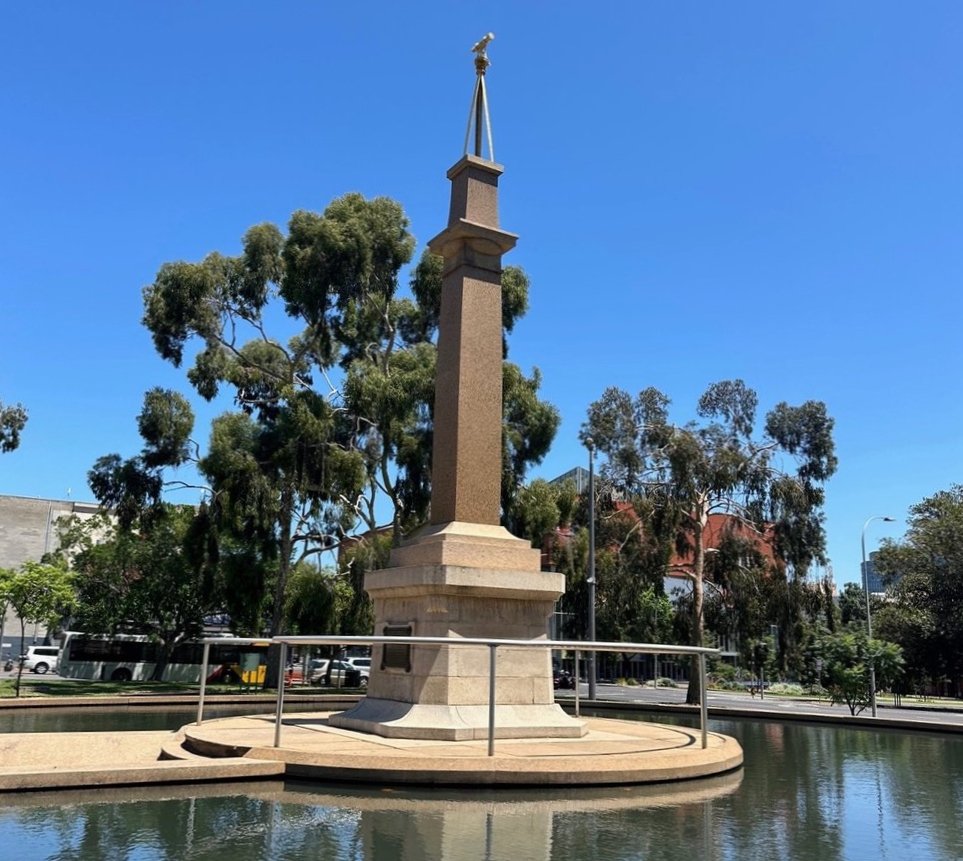by Noris Ioannou
This is the first in a series looking at Park Lands historical monuments, specifically those that cover historical events (aside from war memorials).
Colonel William Light. A self-portrait, 1815
I’m especially interested in examining those monuments whose design or other features allow us to imaginatively connect over time to the historical event/s they portray.
A worthy starting point is to look at Park Lands monuments that refer to and celebrate Colonel William Light (1786-1839), South Australia’s first surveyor-general.
It was his foresight and vision that led him to the selection of the site for the new colonial settlement, and for the unique design of the colony’s capital, Adelaide, which gave us a city within a Park.
It’s appropriate to begin with the Colonel Light Survey Marker, erected in 1929 on North Terrace, as it literally marks the very unfolding of events in the new province.
Specifically, the monument sets the location of Colonel William Lights’ tent, and the locality nearby from where he commenced the survey of Adelaide.
The simple granite memorial, shaped as a round-topped obelisk, is inset with a bronze plaque, which reads in part (and in capital lettering):
“Hereabouts, in January 1837, the survey of the City of Adelaide was begun … Here also in 1837 were erected the first public offices … Adjoining these offices, which were built of wood, were the dwellings of James Hurtle Fisher, the first resident commissioner, and William Light, first surveyor-general.”
The text concludes:
“The buildings were destroyed by fire on January 22, 1839.”
Adelaide Survey Monument. Photo: Monument Australia.
This refers to the tragic event when Colonel Light’s tent, containing his worldly possessions, diaries and paintings, was destroyed.
This unimposing though significant monument stands in landscaped gardens, fronting the new Royal Adelaide Hospital — a hospital built on your former Park Lands in Park 27. The spot could be said to mark the centre or navel of Adelaide’s beginnings.
It is sobering to stand before the monument and visualise, with the mind’s eye, Colonel Light’s tent on the once-grassy bank that sloped down to the River Torrens / Karrawirra Parri.
Colonel William Light painting, 1837, The Commencement of Colonisation in South Australia.
Now turn around, with your back to the monument, and look across the street to the corner of North Terrace and West Terrace.
Today a busy intersection with trams and cars, back in January 1838, there existed an open woodland of gumtrees, acacias and native grasses, stretching to the distant blue Adelaide Hills.
Imagine Colonel William Light standing, looking through a theodolite mounted on a tripod, as an assistant holds a vertical staff some distance away.
This was Light beginning the survey and division of the town acres. Now come back to the present and cross North Terrace to the north-west corner and the Victorian splendour of the 1883 Newmarket Hotel.
The building stands on Town Acre 1, where Light began his survey of the city in January 1838. The first hotel on this site, the Newmarket Inn, was licensed in 1847.
Gaze down at your feet to view a circular bronze plate, set in the paving, which marks the exact spot the survey began. Pause and realise that you stand where Colonel Light stood some 187 years ago!
Sometimes referred to as ‘Trig Station A’, this bronze plaque is at the exact point where Colonel William Light began his historic survey of Adelaide and the plains.
From here, Light Square / Wauwi, one of the five public squares Colonel Light included within the Adelaide city square mile, is but a short walk. This is where Light’s ashes are interred.
His memorial consists of a square column or obelisk, with a model of a surveyor’s theodolite mounted on top. The whole sits within a reflecting pool.
Colonel Light’s ashes are interred at Light Square / Wauwi.
Finally, a visit to the Light’s Vision statue on Montefiore Hill in Tarntanya Wama (Park 26) completes our journey into the past.
Here stands an imposing life-size 1906 bronze statue of Colonel William Light. His figure points across your Park Lands to the city and Adelaide Hills beyond, although the once expansive panorama is now mostly dominated by the Adelaide Oval.
The lightly wooded plateau, which Light surveyed and divided into town acres, has been replaced by a glittering skyline of modest skyscrapers.
Colonel Light’s statue at Montefiore Hill (also called Light’s Vision) was moved here from Victoria Square / Tarntanyangga in 1938. Photo: Adelaide Writer.
Dr Noris Ioannou is an Adelaide-based cultural historian whose writing over the past 40 years has focused on material folk culture and the decorative arts.
His landmark eight books include Ceramics in South Australia 1836-1986: from folk to studio pottery (1986), which received the 1987 Australian Heritage Award, and The Barossa Folk: Germanic Furniture and Craft Traditions in Australia (1995).
His popular cultural travel book, Barossa Journeys: Into A Valley of Tradition, is now in its third printing by Wakefield Press. His most recent book, Vernacular Visions A Folklife History of Australia: art, diversity, story-telling, was published by Wakefield Press in 2021.
Dr Noris Ioannou.














